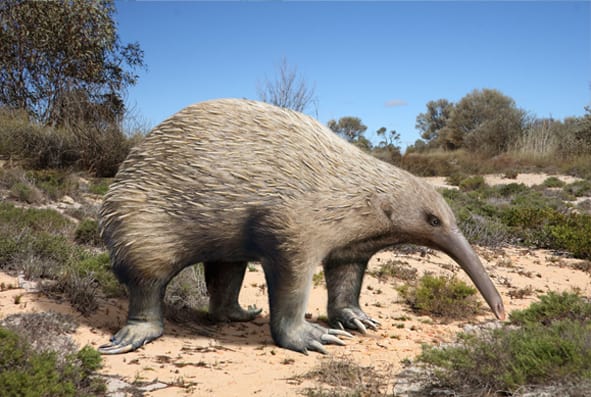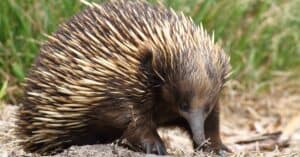Prehistoric creatures are relatives of the animals we see today. Although some ancient animals like horseshoe crabs are still alive, the majority of prehistoric animals have gone extinct. Fossils are the most important evidence scientists use to learn about the animals of the past. Here you will learn about the now extinct sheep sized egg-laying mammal found in Australia, known as Murrayglossus hacketti.
In prehistoric times Australia was home to giant animals like diprotodon, meiolania, and megalania. Murrayglossus hacketti was a large mammal around the size of a sheep and is a species of echidna. While today echidnas are much smaller than those of the past, they have helped us learn about the now extinct animal that once roamed Australia.
What is Murrayglossus?
Murrayglossus is a genus within the Tachyglossidae family. Today there are two extant members within this family, which are Tachyglossus and Zaglossus. The Murrayglossus is an echidna. Belonging to the order of Monotremata, they are close relatives to the platypus.
Murrayglossus hacketti is the only known member of the Murayglossus genus. They are also called Hackett’s giant echidna. They lived in western Australia, and fossils date this animal back to the Pleistocene period.
Description of Murrayglossus

Murrayglossus hacketti is similar to the echidnas that we see today.
Murrayglossus hacketti had a length of around 3.3 feet long, and a weight of 66 pounds. They had very straight legs, which helped them traverse through dense woodland habitats. Depictions of this species show they resembled modern echidnas, with spikes covering them. In depictions, this species’ beak is extremely long, like modern long-beaked echidnas. New fossil discoveries of this species can allow us to get a more accurate understanding of how this animal looked and lived.
Discoveries and Fossils
Fossils of the Hackett’s giant echidna were first excavated in 1909, in Mammoth Cave in western Australia. Fossils from this cave are from the Pleistocene period, and excavation sites have yielded animals like Zygmatrurus, and several shark fossils.
The first Murrayglossus fossils were excavated with other specimens of Sthenurus and Macropus fossils. Ludwig Glauert described the Murrayglossus in 1914. This species’ name is in honor of John Winthrop Hackett. He was a newspaper editor, politician, and financial supporter of the exploration expeditions of the caves where the fossils were found.
Only a few vertebrae and leg bones of this species were discovered. Their cranial material was completely missing upon discovery. Originally this species was put in the Zaglossus genus. However, they were placed in their own genus of Murrayglossus in 2022.
Diet of Murrayglossus

The Hackett’s giant echidna likely had a similar diet to the modern-day echidnas.
©Jukka Jantunen/Shutterstock.com
Hackett’s giant echidna likely had a similar diet to the modern echidnas alive today. These animals are carnivorous and feed on small insect invertebrates. While short-beaked echidnas feed on ants and termites, long-beaked echidnas feed on earthworms. The Hackett’s giant echidna was likely an insectivore and lived in dense woodland habitats in prehistoric western Australia. The large size of this animal made it likely they had to eat a large number of bugs to survive.
Extinction of Murrayglossus
Murrayglossus hacketti lived during the Pleistocene period. it is not yet known when this species went extinct. Australia was filled with megafauna during this time period, as well as early humans. Burn marks and chippings in the fossils found of this animal suggested that humans likely hunted them. There have also been ancient wall paintings that could be depicting this giant animal or the modern long-beaked echidna.
Hunting by the first aboriginal Australians and habitat loss are the possible causes for the Hackett’s giant echidna’s extinction. Plus, in Australia, the extreme environmental changes are one of the main reasons for the continent’s loss of the megafauna it housed.
Similar Animals

The platypus is one of several monotremes that still exists today.
©John Carnemolla/Shutterstock.com
Monotremes like Murrayglosus are estimated to have existed for around 130 million years. Short-beaked echidnas, long-beaked echidnas, and the platypus are the only monotremes alive today. Monotremes are the earth’s oldest living mammals and are an ancient species.
Compared to the now extinct Murrayglossus, echidnas today on average are much smaller, and only grow to be around 11 to 22 pounds. They have spikes that cover them, which are their main defense against predators. They roll into balls or dig to defend themselves when attacked.
Murrayglossus, like the monotremes alive today, are all egg-laying animals. Echidnas lay eggs in their leather pouch around a month after mating. Even though monotremes are mammals, they lack nipples. Their young lap up milk from the milk patches inside their mother’s pouch. In prehistoric times Australia had tons of animals like the Murrayglossus that were large, and resemble the modern animals of today.
Up Next:
Thank you for reading! Have some feedback for us? Contact the AZ Animals editorial team.







